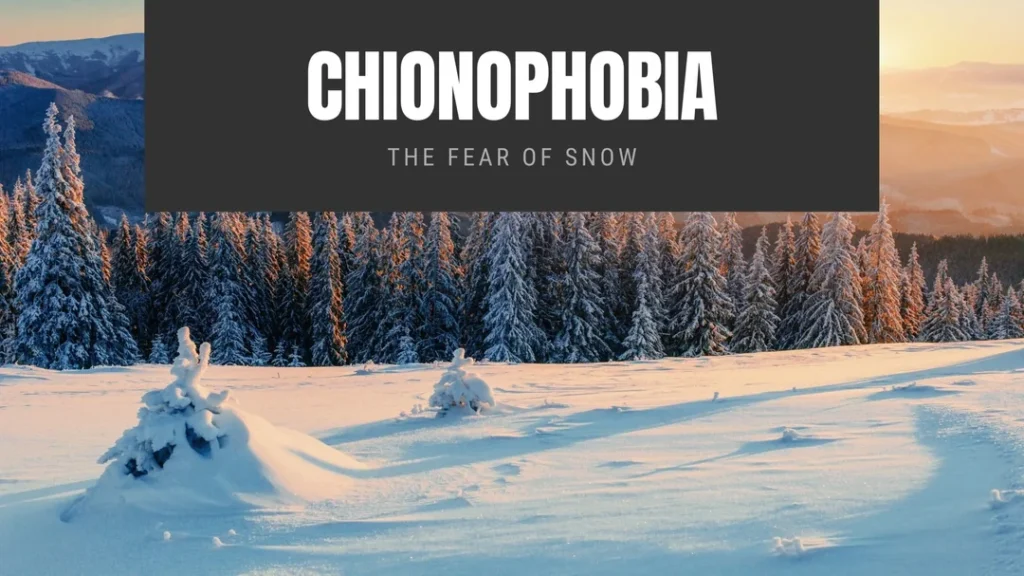Chionophobia is a specific phobia. It is an intense fear of snow. In the enchanting realm of winter wonderlands where many people find joy and beauty in the snow. There exists a lesser-known struggle called Chionophobia. This unique fear of snow can cast a shadow of irritation on the winter season. It is especially for those grappling with its intensity.
This article sheds light on the various aspects of Chionophobia. Its symptoms, causes, and impact on daily life. It also discusses its prevalence and effective treatment approaches. If you or someone you know is struggling with Chionophobia, it’s important to understand its nature. Also seek professional help for managing and overcoming this fear.
What is Chionophobia?
Chionophobia is derived from the Greek words “chion” meaning snow and “phobos” meaning fear. It is characterized by an overwhelming aversion or dread of snow. Unlike a rational concern for severe weather, Chionophobia is an irrational fear often linked to anxieties about being snowbound or stranded in snowy conditions.
Prevalence and Demographics
Chionophobia falls under the umbrella of environmental phobias and ranks as the second most prevalent subtype according to the American Meteorological Society. Understanding the prevalence and demographics of this phobia provides vital insights into its societal impact and the need for increased awareness.
Symptoms of Chionophobia
Individuals suffering from Chionophobia exhibit a wide range of symptoms.
Let’s talk about Mental health and chionophobia, and the psychological impact of Chionophobia on individuals:
- It causes anxiety causing overwhelming feelings of unease and apprehension among people associated with the presence or anticipation of snow.
- People experience panic attacks in intense episodes of fear which are often accompanied by physical symptoms, triggered by snow-related stimuli.
- Many people experience involuntary shaking or trembling which reflects the heightened emotional response to snow.
- A pervasive feeling of impending disaster or catastrophe linked to snow is experienced by individuals even in non-threatening situations.
Chionophobia physiological symptoms are:
- It causes difficulty in breathing or a sense of breathlessness which contributes to the overall distress experienced.
- People experience a feeling of queasiness or discomfort in the stomach due to aversion to snowy conditions.
- People get excessive sweating even in cold environments as a physiological response to the fear of snow.
- People show avoidance behavior reflecting the desire to escape the perceived threat.
Impact of Chionophobia on Daily Life:
Snow phobia causes the following impacts on individuals.
- Social Isolation: The fear of snow can lead to withdrawal from social activities and outdoor engagements that foster isolation.
- Strained Relationships: People face difficulty in participating in winter-related activities that may strain their relationships with friends and family.
- Diminished Quality of Life: Chionophobia can limit the daily activities of people by impeding one’s ability to enjoy the beauty and cultural significance of snow.
- Anticipation Anxiety: The mere forecast of snowfall can trigger anticipatory anxiety which disrupts regular routines and causes distress.
Understanding these symptoms and their impact is crucial for coping with Chionophobia and overcoming fear of snow to address both the psychological and physiological aspects of Chionophobia.
Causes and Risk Factors of Chionophobia:
Chionophobia is the intense fear of snow that emerges from a complex interplay of diverse factors:
- Past traumatic experiences with snow, such as being trapped or lost in a blizzard can serve as significant triggers for the development of Chionophobia.
- Individuals who have endured severe weather conditions that result in distressing situations may associate snow with danger and fear.
- Genetic predispositions also play a role as individuals with a family history of anxiety disorders or specific phobias may be more susceptible to Chionophobia.
- Moreover, irrational beliefs about the inherent dangers of snow that are rooted in personal experiences or cultural influences can contribute to the formation and intensification of this phobia.
- Media portrayal of extreme snow-related events, depicting scenarios of peril and chaos, can further imprint negative associations with snow, shaping the cognitive landscape of individuals susceptible to Chionophobia.
Understanding these diverse causes helps overcome the fear of snow to cope with the Chionophobia.
Treatment Approaches for Chionophobia
Effective Treatment approaches for Chionophobia include:
1. Multifaceted Approach:
Individualized treatment plans are made after recognizing the uniqueness of each person’s experience with Chionophobia. The intensity of the person’s fear and its impact on daily life are evaluated to determine the most appropriate therapeutic interventions.
2. Therapeutic Methods:
Cognitive-Behavioral Therapy (CBT) is a widely used therapeutic approach that focuses on identifying and challenging irrational thoughts and beliefs among individuals related to snow. CBT equips individuals with coping mechanisms and practical strategies to manage their fear.
Gradual and controlled exposure to snow-related stimuli helps individuals to confront and overcome their fear of snow. This systematic desensitization enables a shift in perceptions and reactions of people to snow.
In some cases, anti-anxiety medications are prescribed to alleviate the symptoms associated with Chionophobia. Medication is often used in conjunction with psychotherapy for comprehensive treatment.
3. Professional Guidance:
The significance of seeking professional assistance for Chionophobia should be understood. Mental health professionals; psychologists and therapists play a pivotal role in guiding individuals through the treatment process. Professionals collaborate with individuals to develop personalized treatment plans for them by integrating therapeutic methods, lifestyle changes, and coping strategies to address the specific challenges posed by Chionophobia in their lives.
4. Holistic Approach:
Lifestyle adjustments are recommended to complement the treatment which include gradual exposure to snow, education about different snow conditions, and the incorporation of relaxation techniques into daily routines to help individuals overcome their fear of snow. It also needs a robust support system, comprising friends, family, and mental health professionals which contributes to the holistic approach to treatment. Support enhances the individual’s ability to navigate and overcome Chionophobia.
5. Encouraging Progress:
Regular assessments and progress monitoring are integral components of Chionophobia treatment. Adjustments to the treatment plan may be made based on the individual’s response and progress over time. Another thing is recognizing and celebrating milestones achieved during the treatment process reinforces positive changes and fosters a sense of accomplishment.
Effective treatment for Chionophobia requires a comprehensive and integrated approach that addresses the unique needs and experiences of individuals grappling with this fear.
Conclusion
Chionophobia is a real and impactful fear of snow that can affect various aspects of an individual’s life. It is important to recognize the symptoms. Also, understand the causes, and seek appropriate treatment to cope with this fear. With a combination of therapeutic interventions, and lifestyle changes. You can also get support from mental health professionals. People can regain control and lead lives free from the limitations imposed by Chionophobia. Remember that help is always available for you. Seeking help is a courageous step towards a brighter future.
Medical Disclaimer: We only provide information for educational purposes. Do not consider it a medical advice for you. In case of need, consult the healthcare professional for proper diagnosis and treatment.
Disclaimer: The content on Wellness Derive is for informational purposes only and not a substitute for professional medical advice, diagnosis, or treatment. Always consult a healthcare provider for medical concerns.



